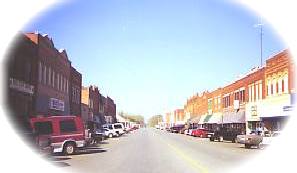
The ceremony and social life of the Plains American Indian are beautifully captured in murals at the Anadarko Post Office, the former home of the Kiowa Indian Agency of the Bureau of Indian Affairs, and listed on the National Historic Register. The east side of the building still shows its former name.
The 16 panels were designed by the late Stephen Mopope, one of the original Kiowa Five artists. Commissioned by the U.S. Treasury Department in 1936, this was the largest mural commission ever awarded to a Southern Plains Indian artist. The late James Auchiah, who lived at Carnegie, assisted in the paintings of the mural. Understanding of the Indian symbolism can greatly increase the appreciation of the murals.
"The Deer Hunter," pictured above, tells the story of a hunter returning with deer, but only after an extremely long trek, since game is scarce.
"Two Men in Council" is a painting to help remind us of the Sun Dance. The man holding the ceremonial fan is the chief of the Sun Dance. The Sun Dance was traditionally held each summer, before the buffalo hunts to insure a good supply of meat and materials for the winter months. Both men have their braids wrapped, a ceremonial sign, and both wear leggings and hats decorated with a feather.
"The Eagle Dancers," "The Fancy War Dance and Cedar Wood Flute," "The Scalp Dance," "Individual War Dance Drummer," "Eagle Whip and Flute Dancers," and "Two Women and Child Watching Dancers" symbolize the various occasions where dance ceremonies are performed.
Three large murals depict the Kiowas preparing to move south for the winter. "Kiowas Moving Camp" and "Kiowa Camp Site" show the chores performed by the entire family and the activities during winter life.
Other murals reveal the importance of the buffalo in the Plains Indian's lives with "Buffalo with Crossed Arrows Behind It," "Medicine Man's Shield and Lance," "Buffalo Hunting Scene," "Buffalo Hunter Shield." "Fresh Buffalo Head" ends the story told in the murals. It signifies health and food for all and a new beginning to the cycle of life on the Plains.